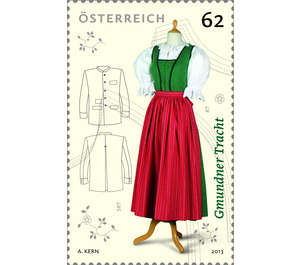strive - Austria / II. Republic of Austria 2013 - 62 Euro Cent
Theme: Devices, Items & Instruments
| Country | Austria / II. Republic of Austria |
| Issue Date | 2013 |
| Face Value | 62.00 |
| Edition Issued | 812,000 |
| Printing Type | offset |
| Stamp Type | Commemorative |
| Item Type | Stamp |
| Chronological Issue Number | 2424 |
| Chronological Chapter | OOS-OE2 |
| SID | 200616 |
| In 64 Wishlists | |
The present special stamp marks the beginning of the new series "Classical Costumes" - a series that combines traditionalism, homeland, fashion and everyday life in a contemporary interpretation and corresponding imagery in an interesting way. The first issue focuses on the costume from Gmunden, a charming town on the north shore of Lake Traun in the Upper Austrian Salzkammergut. Already during the k. u. k. Monarchy was Gmunden as a renowned summer resort, but even today, counting about 13,000 inhabitants city is one of the most popular resorts in the region. The term costume (from Old High German "traht (a)", middle Low German "dragon": "what is worn") is generally defined as traditional or historical clothing. It is the dress code of a specific area, a country or members of individual population or professional groups. In many parts of the world, traditional clothing has been largely pushed back in the course of globalization, which includes culture and fashion, and in many places has been worn only in the form of a so-called "festive costume". Of course, in some areas people still put on traditional everyday clothing - and what is a kilt in Scotland, a sari in India or a kimono in Japan, that is dirndl and lederhosen, the clichéd image promises in any case Austria. The origin of the traditional clothing of folk costumes dates back to the Biedermeier and Rococo periods, and in contrast to other types of clothing, national costumes are well defined in terms of color, cut, choice of fabric and even the way they are worn. It usually distinguishes between the so-called "workday costume" and the "festive costume", the latter is often made very expensive. The "success story" of the Gmundner costume is probably that, despite all tradition, over time, has changed slightly over time - so you can find in their history here and there also fashionable influences. The dirndl were sometimes more, sometimes less long, and the colors of the individual garments varied again and again. However, one thing is for sure: in Gmunden the costume is alive and is certainly more than just a relic from bygone days. And so it is almost a matter of course that you go here on solemn occasions with the best "G'wand" - and that's just the pretty Dirndl and the janker janker.


